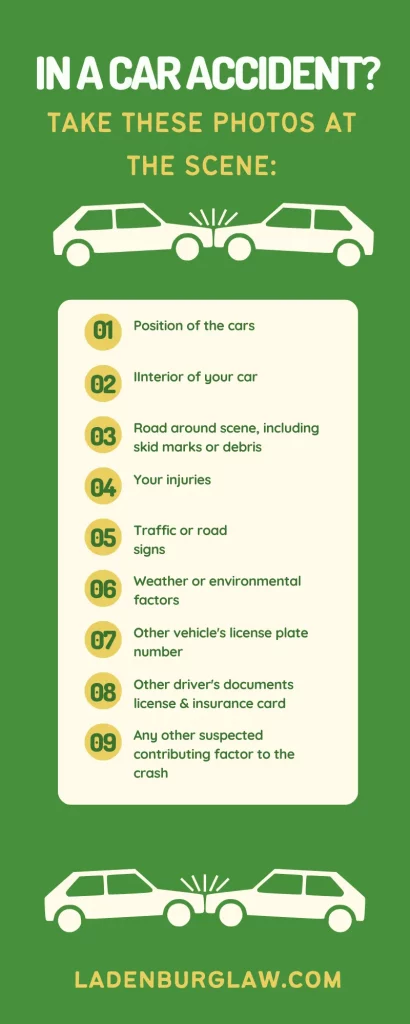Free Case Evaluation
(253) 272-5226Free Case Evaluation
(253) 272-5226No one plans for a car accident to happen, but many of us will experience one at some point. It’s a good idea to be knowledgeable ahead of time about what you should do at the scene of a crash.
One of the most important steps you can take to preserve evidence is also a simple one: take pictures. Today we’ll explore some of the types of pictures that may be most useful. While we hope you won’t need it, we encourage you to bookmark this post or print it out and save it in your glovebox.
Before we dive into this topic, we have a caveat. (We’re lawyers, what can we say?) Your health and safety always come first!
Sometimes, the safest place for you to be immediately after an accident is in your vehicle until help arrives. Walking around the accident scene to take photos could put you in danger of being hit a second time. This is particularly true if the accident is in a busy intersection or freeway. No amount of money or extra evidence is worth your safety. So please, exercise caution and good judgment.
You do not need a fancy camera to take accident scene photos. Most phones work perfect for this job! Another benefit of using your phone is that time and location data get saved with every photo. This provides an additional layer of evidence for your case.
If it is safe to do so, taking pictures can help tell a story about how your collision happened. Pictures can also be a powerful form of evidence to demonstrate who was at fault.
Here are a few tips to consider:
Not in a position to take photos? Ask a passenger or witness to assist.
When it comes to accident scenes, the more pictures, the better. It’s always better to err on the side of having too many photos than too few.
Here is a list of photos we suggest you take:
There is a short window of time to gather this valuable evidence, so remember, the more photos you take, the better.

One of our attorneys, Erik Ladenburg, has compiled many of the questions he gets asked about car accidents and addressed them in a book called What Insurance Companies Don’t Want You To Know.
This e-book covers everything from what to do at the scene of an accident to how to handle phone calls from the insurance agent and more.
We’d like to offer this resource to you at no cost. Please request your copy by filling out the short form and we’ll send it by email.
Our team has decades of experience helping victims of car accidents through the claims process and win fair settlements. There’s no fee to talk with one of our attorneys to learn more. We also work on a contingency basis which means you only pay us if we win you a settlement.